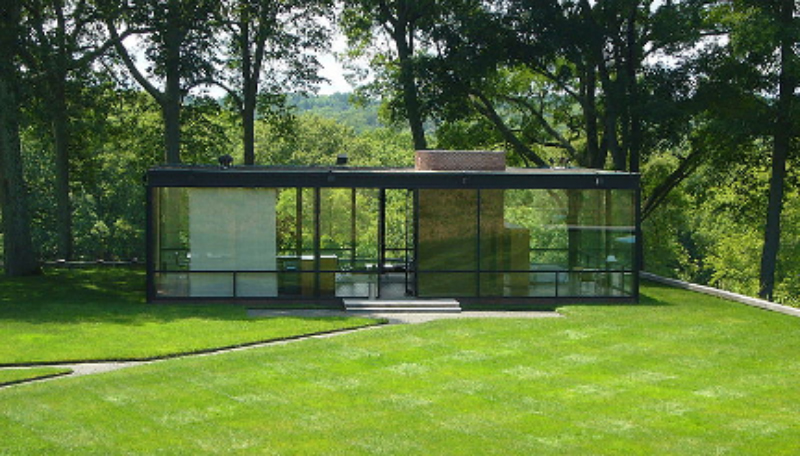Residential real estate – What is trending today - by Marc Nadeau

Nadeau & Associates
The architectural landscape in New England has long been rooted by the traditional form that we all know so well. Terms to that roll off our tongues include that of colonial or cape style residences, along with ranch, raised ranches, split levels and the ever-present vernacular.
All grew out of previous architectural forms, many dating back to the 1600’s and 1700s. The style that emerged during the mid-Twentieth Century and caused the biggest splash in the architectural world is that of Modern or Mid-Century Modern. Championed by the likes of Walter Gropius, founder of the Bauhaus Movement, Marcel Breuer, Phillip Johnson, Ulrich Franzen and countless other architects and designers that followed, it is the style that is perhaps most misunderstood and least embraced (until recently).
The image below is that of Phillip Johnson’s “Glass House,” which is located in New Canaan, CT. An iconic structure, that today is owned by the National Trust for Historic Preservation and is available for tours.

Highlighting the misunderstanding of the style for me occurred at a seminar that I was giving about ten years ago. I put the aforementioned Glass House up on the Power Point presentation and one woman exclaimed “what’s that?” Another fellow said “It looks a bit like a Jiffy Lube.” When I said to them, that it was a $6 million Jiffy Lube, their ears perked up and wanted to know more.
The market has since evolved from that day with a greater percentage of the marketplace now embracing the Modernist Style of architecture, which has moved in step with the appreciation and demand for Modernist furniture as well as modern and abstract art.
The days of old when the glass and steel houses were held in distain, a Wassily Chair by Marcel Breuer was considered by many to be a “contraption of leather and steel” and paintings by Willem De kooning went under-appreciated, the market for all three genres have turned around over the past 20 or so years.
It was only a dozen or so years ago when I had the task of performing an appraisal for an estate valuation. The property in question was a modest little post-war Tudor style home that was being inherited by the decedent’s son. I noticed what I thought to be a De kooning painting hanging on the wall in the study. The person who was the beneficiary of the estate noticed that I was looking at the painting and offered to sell it to me for $300, or else it would be placed at the end of the driveway for a tag sale.
My hunch was correct, it was a real De kooning! It was later sold through Sotheby’s Auction House for $11.4 million. The fellow who inherited the property was most appreciative that I declined his offer to buy the painting for $300.
The same can be said for Modernist furnishings that have truly gained a stronghold in today’s furniture market. Retail outlets such as Design Within Reach, sell reproductions of Breuer, Eames and Jensen furnishings with today’s versions of the Wassily Chair selling in excess of $5,000 for the reproduction chair. The originals can sell in excess of $20,000!
Today’s Modernist style homes: The style, where the construction is often rooted in lightweight steel framing and extensive glass perimeter walls is credited for its structural strength, its open interior spaces that allow for a greater latitude for room formatting and the benefit of natural light transfer through the space.
All of the above was true for the original structures that graced the landscape starting from the 1940’s. The problems that sometimes evolved with the original structures was that of inferior (and what were new) materials at the time, which included roof materials, window design and experimental siding materials. All of these elements have been greatly improved upon, opening the door for improved versions of the original designs.
Today’s versions offer as mentioned, a greater latitude of formatting which when combined with the improved design of passive solar windows and geothermal heating and cooling result in the most energy-efficient structures being built today.
Value of Design and Provenance
In New England, we have a relatively small population of Modernist style homes that stem from the original Mid-Century design however, that population is growing and taking a greater position in the marketplace. As the market becomes more aware of the style and its benefits, the value of both original and newly designed and built structures continue to appreciate.
The original designed and built Modernist homes have further demonstrated a premium value over and above that of its contemporary counterparts, especially if the dwelling was designed by a well-known architect. One of the most recent examples of that would the sale of a Marcel Breuer designed home in Orange, Connecticut on Derby-Milford Road. The home, which was built in 1951, was an excellent example of the Modernist style and was extremely well-cared for. This 2,900 square foot sold for $999,000.00 in May of 2018, more than twice the average of similar sized homes that would be considered contemporary counterparts.
Summary
Today, perhaps more then ever, good design equals value, and that value often being a premium above most competing product of like utility in the marketplace.
Like many things of value, whether homes, furnishings, artwork and other collectibles, the values will ebb and flow with the changing attitudes and wants of the marketplace. Today, Modernist designs are enjoying an ever-increasing popularity. After all, everyone needs a great Modernist home to go with their De kooning!
Marc Nadeau, SRA, is owner of Nadeau & Associates, Guilford, Conn.







